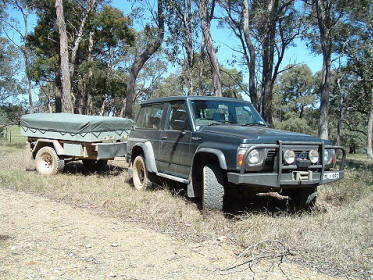|
camper safety
check
before you
drive away

As a duty of care to other
road users it is a good idea to do a mandatory safety check of your
camper trailer before driving away. You also have peace of mind
knowing everything is where it is suppose to be and nothing is left
open loosing valuable items along the road. There is nothing worse
than getting into camp & finding there are no tent poles because you
havenít shut the pole carrier that morning.
The coupling is a good starting point to work your way around the
camper ending at the front on the opposite side. Even though you may
have connected the camper to the vehicle a few minutes ago, double
check to see if the pins and clips of the off road coupling are
correctly in place or the ball coupling is properly seated with the
locking mechanism clipped in. Some couplings have double locking
safety mechanisms, particularly off road versions. If using a
locking Treg pin, make sure the dust cap is in place.
Directly below the coupling are the safety chains. If you have
double chains they should be crossed over and secured to the tow
vehicle with suitable sized shackles. Donít use padlocks or
carabineers as they are not seen as a recognized safety connection.
Next to the coupling and safety chains are the trailers lights
connector. At some point of the safety check you should look to see
if the tail lights are working. The trailer plug and socket
connector always seem to be a problem particularly if you have not
used the camper for some time. A continual wiggle usually gets the
problem lights working, however a little pre-trip maintenance is
always a good thing.
The male plug on the trailer can always been given a rub over with a
green dishwashing scourer pad to brighten the contacts. The female
socket on the rear of the tow vehicle builds up a fair bit of
verdigrease and is harder to clean. The guys at Jaycar recommended a
spray of Inox or WD40 and a gentle clean with a fine wirebrush,
giving the connection another spray to clean it out before letting
dry with a protective coating.
If you have an Anderson plug to charge the campers battery while
driving, make sure it has snapped into place properly and no wires
are hanging loose that could be ripped out by sticks.
Disengage the trailers handbrake & if you have an overrider brake
system, place the lockout in the open position. Check to see if the
jockey wheel is in its locked horizontal position or if a removable
version, has been taken off & stowed.
The position of jerry and gas bottle holders will depend on the
style of camper you own. Some are positioned across the front of the
trailer while others have carriers on the sides. Make sure they are
secured as you walk around by giving them a little tug. If you have
been driving over gravel roads check to see if rocks have not worked
their way down the back or even under the jerryís that will
ultimately rub a hole through, leaking their valuable contents along
the track.
Check that all gas bottles have been turned off and a plastic cap
has been placed on the outlet to stop dust and mud from entering the
valve area. It doesnít take much to clog the gas jets on gas stoves
and even harder cleaning them so you can cook.
Some campers have lockers on the side so check to see if they are
closed and locked.
Check the tyre pressure while they are cool. I have been using the
4lb rule for years on both the vehicle and camper. You need to run
at highway speed for at least an hour to give your tyres a chance to
build up enough heat. What you are aiming for is an increase of 4lb
from your cold pressure reading.
If you are over the 4lb you have not put enough air in the tyres
from cold. An under inflated tyre drags on the road generating heat.
If you are under the 4lb, you have put too much air in when the tyre
was cold. Over inflation when cold will not generate enough heat.
You can build up a chart for cold tyre pressures of varying loads
for the vehicle & trailer. The 4lb rule is not recommended for the
low profile tyres some new generation 4wdís are running.
If you have any wind down stabilizing legs on the rear make sure
they are up and secured. Some wind down legs have a recess the leg
will fit in and then extends into it to make them rattleproof while
others are simply fixed with pins, R clips or threaded bolts.
The different styles of campers have their own configuration when
packed. If it is a soft floor camper check to see if the travel
cover is secured either by bungie straps or with zips and velcro. If
you have a hardtop camper, flip-over or windup, ensure the over-center
latches are closed & any locks in place.
One of the most important things to pay attention to is the tailgate
as if this opens you will have no idea your gear is being dumped
along the track until your next stop which could be many kilometers
away. Check to see if this has been closed and locked.
Working your way up the other side of the camper will be similar to
the first side but donít think been there done that. Pay attention
to the job in hand making sure everything is in order.
You are back to the front and everything is in place ready for the
road. What about that 240volt lead you still have the fridge plugged
into?
Have a safe journey and see you in camp.
written by Rob
february 2011
|